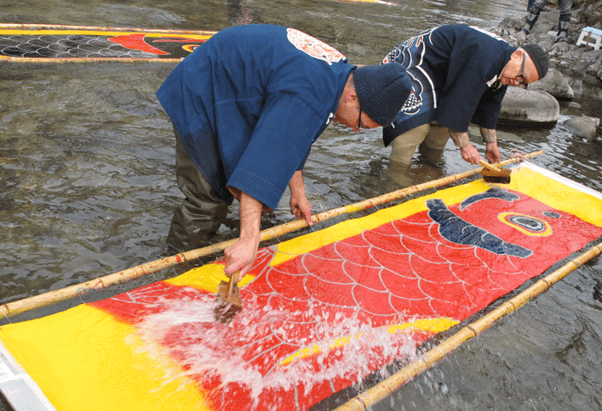Regenerative travel may be a current buzzword around the world, but in Japan, it’s something that has always come naturally. There’s a great respect across the country not only for sustaining the natural world, but also for sustaining cultural traditions, giving visitors opportunities to enjoy enriching travel experiences that are rooted in authenticity. From visiting the workshops of artisans who have been practicing their craft for generations to experiences connecting travellers with Japan’s majestic nature, there are many ways for travellers to have a positive impact while travelling in the country, and to take home unforgettable memories.
In harmony with Japan’s magnificent black bears in Karuizawa
Harmony is an intrinsic part of Japanese culture, not only harmony between humans, but harmony between humans and nature. In Japan, nature is something to coexist with, something to respect rather than conquer. This spirit extends to a sense of reverence and respect for the natural world, and for the flora and fauna that inhabit it. You can experience this firsthand by joining a conservation study tour with Picchio Wildlife Research Centre in Karuizawa and spending time observing Japan’s elusive Asiatic black bears. Picchio has been leading bear conservation programmes since 1998. Join one of the organisation’s wildlife tours and you’ll be immersed in some of Japan’s most beautiful natural scenery, while gaining a deeper understanding of the importance of black bears in the overall ecosystem, how we can coexist peacefully with them, and how human-bear conflict can be avoided. The study tours begin with an introduction to bear protection management at the Picchio Wildlife Research Centre, followed by a field study tour where you will track wild bears by following signals from their radio collars. You may be lucky enough to see them in person, and a team of bear dogs will also accompany you, themselves important members of the research support team and expert trackers. It’s a wonderful way to gain a deeper understanding of Japan’s natural environment, while supporting some valuable work.
Listen to tales of the seafood and dine on fresh seafood with the Ama divers
The ama female divers have been heading beneath the waves in search of the best shellfish and seaweed for generations. Many of the amas are senior in age and experience, and after hard days of diving in cold waters, they warm themselves up by lighting fires in wooden huts to get cosy around and chat before heading out on the next dive. In Ise-Shima National Park in Mie Prefecture, you can join some of the women who still dive today in one such hut. Listen to stories about the tradition, how they dive, what they catch, and how they preserve the marine environment by adhering to sensitive environmental practices. You’ll also have the opportunity to enjoy a meal together made with seafood freshly caught in the waters around Ise-Shima. It’s an ideal experience to enjoy in an intimate setting, and can be reserved for large groups.
The ama female divers have been heading beneath the waves in search of the best shellfish and seaweed for generations. Many of the amas are senior in age and experience, and after hard days of diving in cold waters, they warm themselves up by lighting fires in wooden huts to get cosy around and chat before heading out on the next dive. In Ise-Shima National Park in Mie Prefecture, you can join some of the women who still dive today in one such hut. Listen to stories about the tradition, how they dive, what they catch, and how they preserve the marine environment by adhering to sensitive environmental practices. You’ll also have the opportunity to enjoy a meal together made with seafood freshly caught in the waters around Ise-Shima. It’s an ideal experience to enjoy in an intimate setting, and can be reserved for large groups.
Join a 15th-generation indigo master and dye your own fabric
Japan’s commitment to preserving traditions and crafts is one of the things that makes travelling in the country endlessly fascinating. In the historical castle town of Gujo Hachiman in Gifu Prefecture, you can join a 15th-generation indigo aizome dyeing master to learn about the traditional craft of making “Japan Blue” indigo fabric. The Watanabe Dyehouse has been using natural pigments to make the much-loved indigo fabric, known for its insect-repellent and antibacterial properties, for more than 400 years. Not only will you learn about dyeing techniques, but you’ll also have the opportunity to dye you own t-shirt or stole in the traditional way in the konya dyehouse, the last remaining one in Gujo Hachiman. Kazuyoshi Watanabe and his family have been fermenting indigo leaves with lye and quicklime, then rinsing the dyed fabrics in the town’s well-preserved waterway, for centuries. You can try your hand at dying your own fabric with a pattern of your choice, practicing techniques such as binding, pressing and wrapping, and adding colour gradients. Once your piece is rinsed and dried, it’s ready to take home, a meaningful and unforgettable souvenir of your trip.
From the outside, the Good Nature Hotel may not look very nature-immersed, but once you step inside it’s all very different. The hotel’s ethos is all about sustainability, from running on renewable energy to implementing energy-saving technology, using 100% organic cotton towels, collaborations with local producers in the restaurant and in-house deli, circadian lighting systems in guestrooms, and installing Japan’s largest green-walled courtyard. This is also a hotel for foodies with multiple onsite restaurants and cafes, including two Michelin-starred restaurants, the two-star Velrosier for creative boundary-pushing Chinese cuisine, and one-starred Takayama where guests sit around an open kitchen to dine on dishes centered around a concept of “comfort + excitement = happiness”. And at Hyssop, named for an herb meaning “purification”, a wide variety of lovingly made and aesthetically pleasing dishes inspired by popular food cultures around the world are served throughout the day, including vegan and halal selections. This being Kyoto, it’s only natural that the rooms here would embrace an artistic touch rooted in nature. Walls feature paintings of cherry blossoms and pine trees by Japanese painter Yasunori Fukui, crafted with homemade paints derived from natural elements like soil and stones. Stay here to feel simultaneously immersed in an exciting urban centre with a sense of natural elements all around, as well as knowing that you’re making a sustainable choice and a positive impact.




